| کد مقاله | کد نشریه | سال انتشار | مقاله انگلیسی | نسخه تمام متن |
|---|---|---|---|---|
| 255758 | 503530 | 2016 | 10 صفحه PDF | دانلود رایگان |
• Fundamental parameters controlling strength development of CSCN stabilized earth are investigated.
• Total cement content hypothesis accounting for curing time is proposed.
• The phenomenological models based on fundamental parameters for strength development are established.
As an environmentally-friendly construction technique, modern rammed earth generally stabilized with ordinary Portland cement has attracted growing interest recently. In this study, cement-based composite (CSCN) consisting of cement, sodium silicate and composite promoter is employed to substitute ordinary Portland cement, and self-compacting earth-based specimens without compacting energy are prepared. The variables controlling strength development are investigated by unconfined compressive strength (UCS) and physical property tests. The total cement content (C) is proposed based on the pozzolanic effects of the supplementary cementing materials in CSCN, and the relationships of pozzolanic factors to curing time are also analyzed. The ratio of the porosity to total cement content (nt/C) combines together the variables C, curing time and fundamental parameters of stabilized earth, and the relational expression between strength and nt/C is put forward. To normalize the fundamental parameters, the multiple linear regression is employed to analyze the after-curing unit weight (γt) and total water content (wt), and the power regression is used to analyze the after-curing specific gravity (Gst). Subsequently, the phenomenological models for strength development of CSCN stabilized earth are established. A series of specimens are used to evaluate the precision of the phenomenological models, and the comparison of predicted strength and actual strength implies that the deviation is generally within 10%.
Journal: Construction and Building Materials - Volume 123, 1 October 2016, Pages 336–345
